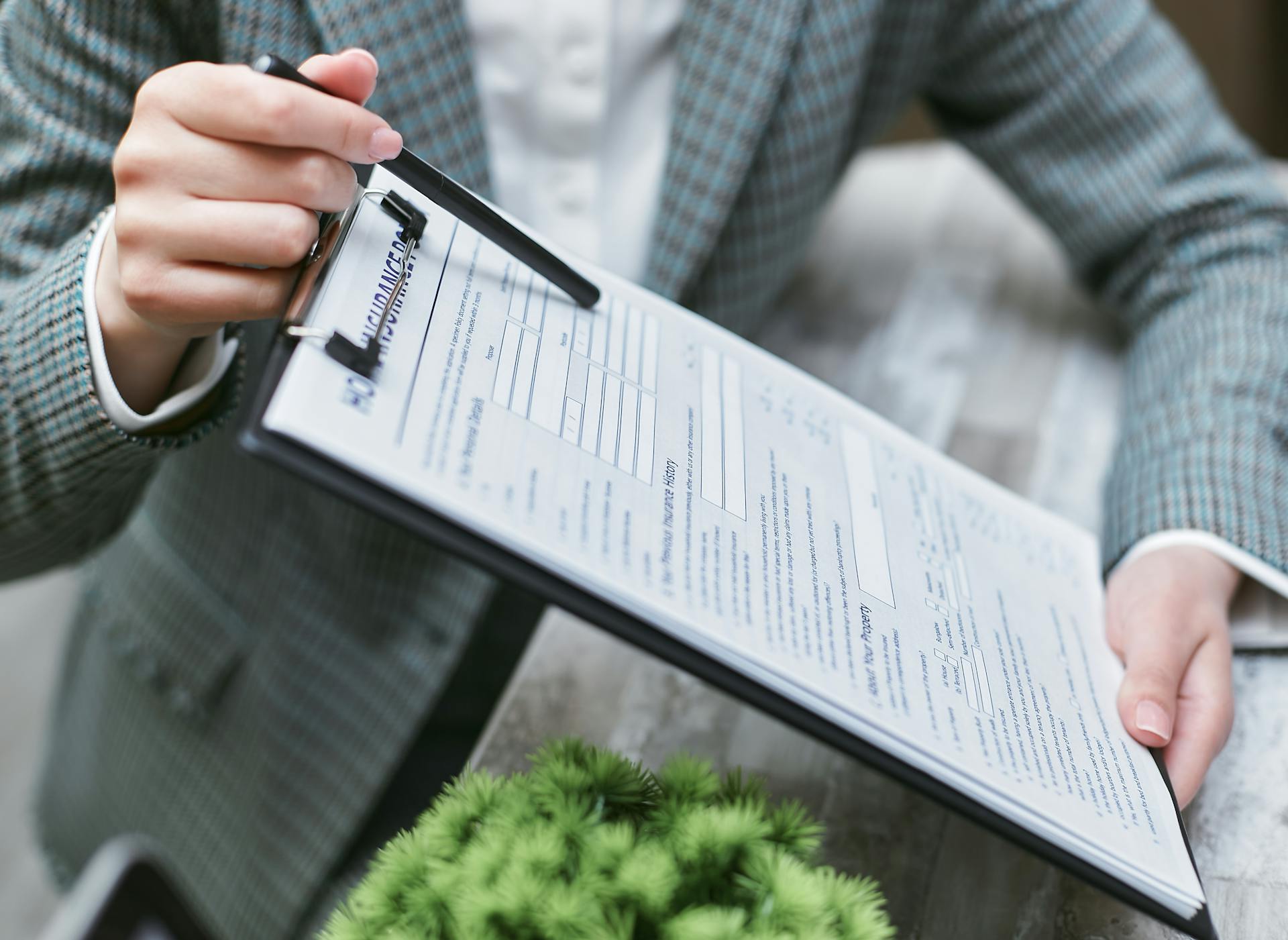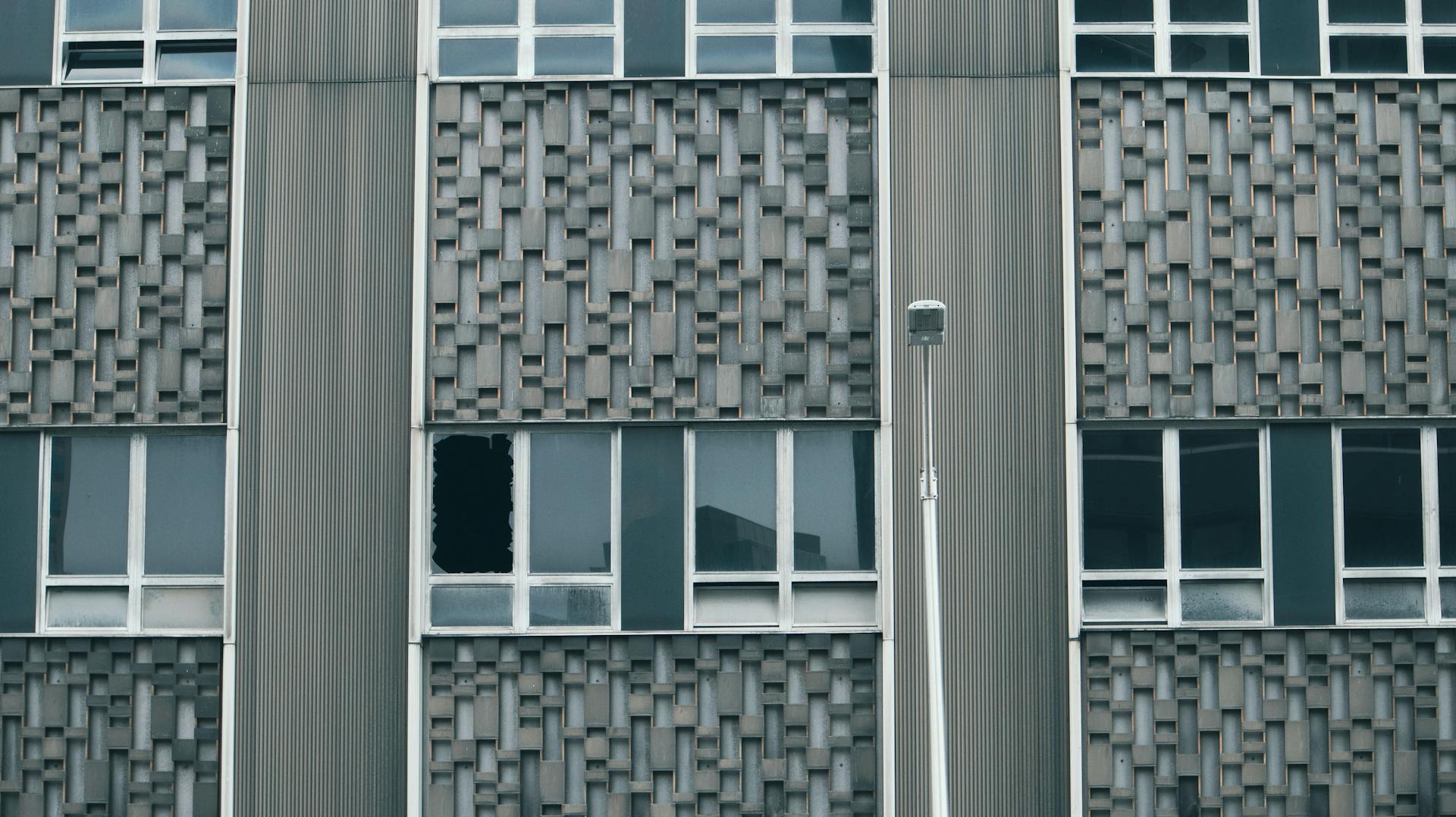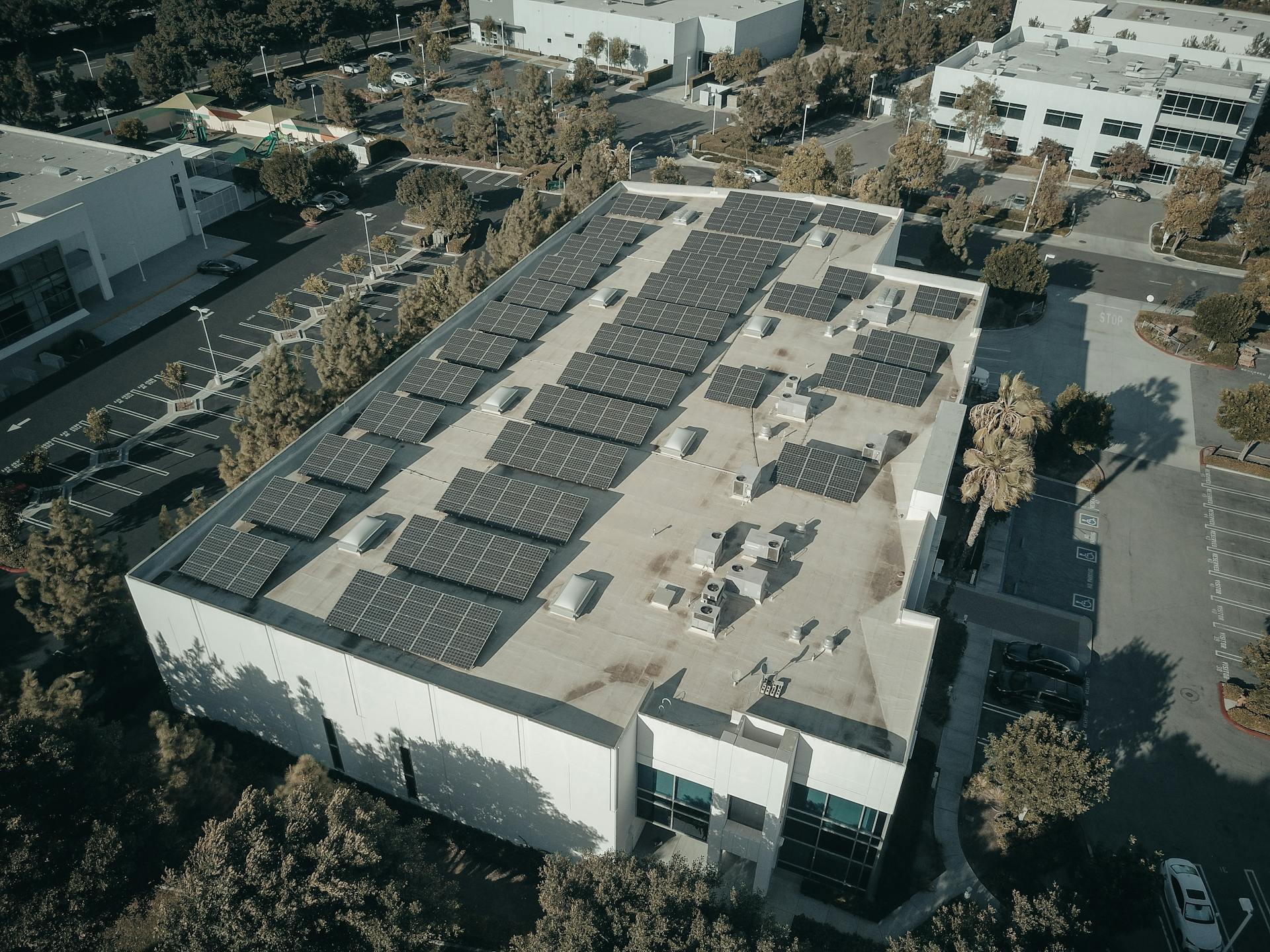
Commercial property insurance costs can vary significantly depending on the type of property and its location. This is because insurance companies consider factors like the property's value, its use, and the level of risk involved.
The average cost of commercial property insurance in the US is around $2,000 to $4,000 per year, according to industry estimates. This cost can be broken down into several components, including premiums, deductibles, and other fees.
Business owners can expect to pay a higher premium for properties in high-risk areas, such as coastal regions prone to hurricanes or areas with a high crime rate. For example, a property in a flood-prone area may cost up to 50% more to insure than a similar property in a safer location.
A unique perspective: Insurance Cover on Business - Merchant Services
What Is Commercial Property Insurance?
Commercial property insurance is a policy designed to protect commercially owned, stationary assets. It covers business-owned real and personal property from covered perils in the policy.
Mobile assets away from the business need a different type of insurance known as inland or ocean marine insurance. This is because commercial property insurance specifically covers assets that are stationary and owned by the business.
There are three types of property coverage forms available for your commercial assets. Here's a brief overview of each:
- Basic form: Covers damage from fire, lightning, explosion, smoke, windstorm, hail, riot, civil commotion, aircraft, vehicles, vandalism, sprinkler leakage, sinkhole collapse (in FL catastrophic ground movement), and volcanic action.
- Broad form: Adds coverage for damage to property caused by falling objects, the weight of snow, ice, or sleet, water damage (in the form of leakage from appliances), and collapse from specified causes.
- Special form: Safeguards business assets from the basic and broad form perils and other losses not listed in the Exclusions section.
Standard exclusions include ordinance or law, flood, earth movement, war, military action, government seizure or destruction, wear and tear, infestation, fungus, wet or dry rot, bacteria, virus, pollution, nuclear hazard, utility services, explosion from pressurized vessels, employee/owner theft, and market loss.
Cost and Factors
The cost of commercial property insurance can vary significantly, with an average annual cost of $756 or approximately $63 per month. This is based on factors such as the size and location of the property, unique risks associated with it, and the amount of coverage needed.
Insurance companies consider a wide range of factors when calculating premiums, including the value of the building or property, the value of physical assets associated with the business, and the level of coverage selected. For example, a business with a large office or manufacturing facility will likely cost more to insure than a small, single-tenant office building.
Explore further: Insurance for 5 Unit Apartment Building
Some of the key factors that affect commercial property insurance costs include location, coverage limits, claim history, and safety systems in place. For instance, a business located in an area prone to natural disasters or theft/vandalism will likely have higher premiums.
Here are some specific factors that can impact commercial property insurance costs:
- The value of the building or property
- The value of physical assets associated with the business
- Level of coverage
- Actual cash value or replacement cost coverage
- Building construction
- Industry
- Location
- Security
By understanding these factors, you can help keep your insurance costs under control and ensure that you have the coverage you need to protect your business against potential losses.
Basics
As you start exploring commercial property insurance, it's essential to understand the basics. A basic policy should protect your property's primary and secondary structures from various perils like fire, explosions, and vandalism.
Commercial property insurance coverage typically includes protection for the property structure. This is crucial because significant financial loss can occur when your property is damaged.
Landlord belongings are also a must-have in any commercial property insurance coverage. This includes furniture, fixtures, appliances, carpets, and other items used to maintain the property.
Loss of income is another vital aspect of commercial property insurance. This policy will reimburse you for the lost rental income you would have earned from tenants when your rental property is uninhabitable due to damages caused by a covered risk.
Here's a quick rundown of the basic levels of coverage you should have:
- Property structure protection
- Landlord belongings coverage
- Loss of income policy
Cost Factors
The cost of commercial property insurance can vary significantly depending on several factors. According to Forbes, the average annual cost is around $756.
The size and location of the property are crucial in determining the premium. A large office or manufacturing facility will likely cost more to insure than a small, single-tenant office building.
Your property's features also play a significant role in determining your premiums. For example, a building with fire-resistant materials and up-to-date electrical systems will be less expensive to insure than an older building without these features.
The value of your assets and inventory also impacts your premium. A business with few physical assets of value will tend to have a lower monthly premium.
Readers also liked: What Does Apartment Insurance Cover
The type of industry you're in also matters. Manufacturing businesses carry a higher level of risk for property damage than office-based businesses, for example.
Your location's crime rates, proximity to a fire station and fire hydrant, and frequency of dangerous weather events can also affect your rate.
A security system can help decrease your property premium. Sprinkler systems and central station fire alarms can also make a difference.
The replacement cost of your property is another factor to consider. The higher the replacement cost, the higher your premiums will be.
Here are some specific premium factors to keep in mind:
- Geography: This can help your insurance provider determine what environmental hazards your company may confront, such as floods, tornadoes, and other covered perils.
- Building Value: A large office or manufacturing facility will probably cost considerably more than a small, single-tenant office building.
- Age of building: Older properties, in particular, have insurability issues.
- Fire protection: Proximity to a fire department and fire hydrants will likely allow you to save some premium when insuring a property.
- Type of equipment: Industrial equipment costing more than a home-based sewing machine will feature heavy insurance coverage.
- Property valuation method: Replacement value coverage costs more than actual cash value coverage.
These are just a few of the factors that can impact your commercial property insurance costs. Understanding these factors can help you keep your insurance costs under control and ensure that you have the coverage you need to protect your business against potential losses.
Curious to learn more? Check out: Commercial Property Insurance Rating Factors
Certain Smoke
Certain types of smoke, such as that from agricultural or industrial operations, can be excluded from commercial property insurance policies.
This exclusion is in place because smoke from these types of operations can cause widespread damage, making it difficult to insure.
These types of smoke can result in significant losses for property owners, highlighting the importance of understanding insurance policy exclusions.
Policy and Coverage
A lower policy limit might save you on premiums, but it's wise to purchase a policy covering all expenses associated with rebuilding or restoring your property to its original condition.
The type of policy you choose can impact your premiums and coverage. For instance, a special form policy provides all-risk coverage for both named and unnamed perils, offering the broadest coverage but also typically being the most expensive.
A policy with open risks will cover all losses, except those clearly stated as not covered, while a policy with named perils will only cover the listed losses. This means that a policy with open risks will generally cost more than one with named perils.
Take a look at this: Can You Write off Life Insurance as a Business Expense
What It Covers
Business property insurance protects physical assets such as the building itself, business personal property, and others' belongings within the workplace.
A business property insurance policy covers against specific causes of loss, which are defined by the policy's forms.

The three main forms of business property insurance are causes of loss forms, which define the types of damage covered.
Commercial property insurance covers a wide range of potential losses resulting from damage to a business's physical property and assets.
There are three main types of commercial property insurance policies: basic form, broad form, and special form.
A basic form policy covers only a limited number of named perils, such as fire, lightning, and explosion.
A special form policy provides all-risk coverage for both named and unnamed perils, making it the most comprehensive type of commercial property insurance.
A policy with open risks will cost more than one with named perils, but it covers all losses except those explicitly excluded by the policy.
A policy with named perils only covers the listed losses, leaving other potential damages uncovered.
Additional reading: Life Insurance That Covers an Insured's Whole Life
Policy Limits
Setting policy limits can be a delicate balance between saving on premiums and protecting yourself against unexpected expenses. A lower policy limit might save you on premiums, but it's essential to consider the potential risks.
If your policy limit for building coverage is lower than the replacement cost, you'll only be covered up to that limit, leaving you to pay the remaining amount. For example, if your policy limit is $1 million and the replacement cost is $1.5 million, you'll have to pay the extra $500,000 out of pocket.
Purchasing a policy that covers all expenses associated with rebuilding or restoring your property to its original condition can provide peace of mind and financial security.
Readers also liked: Condo Insurance Replacement Cost
Broad Form Policy
A broad form policy is a type of commercial property insurance that covers a wider range of perils than a basic form policy.
This type of policy includes named perils as well as additional perils such as theft and windstorms, providing more comprehensive coverage.
You might find that a broad form policy is more expensive than a basic form policy, but it's worth considering if you want to be fully protected against unexpected events.
For instance, if you have a policy limit of $1 million and the replacement cost is $1.5 million, you'll only be covered up to $1 million, leaving you to pay the remaining $500,000.
A broad form policy can give you peace of mind knowing that you're covered for a wider range of perils, including those that might not be explicitly listed in your policy.
Location and Geography
Location and geography play a significant role in determining commercial property insurance costs. Carriers consider factors like natural disaster risks, and if your property is in an area prone to hurricanes, wildfires, or earthquakes, your insurance costs will be higher.
Properties in areas with higher crime rates tend to have more expensive premiums. This is because crime rates are a critical factor influencing insurance costs, and carriers take them into account when pricing policies.
The location's proximity to fire stations, police departments, and bodies of water can also impact insurance costs. This is another factor relating to your property's location that carriers consider.
Arizona, Hawaii, Kentucky, Nebraska, New Hampshire, New Mexico, Oregon, Rhode Island, and Vermont are some states that may have higher insurance costs due to natural disaster risks or other location-specific factors.
Related reading: Natural Disaster Insurance for Business
Business and Liability
Liability coverage is a crucial aspect of commercial property insurance, providing protection against claims made by third parties for bodily injury or property damage that occur on the insured property.
Liability coverage can help protect against claims resulting from accidents, such as slip-and-fall incidents, as well as against claims for advertising injury, such as defamation or copyright infringement.
Having adequate liability coverage can give business owners peace of mind, knowing they're protected in case of unforeseen events.
Discover more: Health Insurance Asking about Accident or Injury
Business
As a business owner, it's essential to consider property insurance to protect your valuable assets. Businesses that operate out of buildings they own should have commercial property insurance.
If you lease or rent space, you might be liable in case of a fire or natural disaster, and your landlord may require you to have business property insurance. While homeowners insurance might cover some expenses, it generally falls short for business owners with more than $2,500 in business equipment.
Business property insurance covers physical assets, including the building itself, business personal property, and others' belongings within the workplace. This type of insurance protects against losses due to theft, fire, windstorm, and other perils.
Business personal property coverage specifically protects the personal property of a business, such as equipment, furniture, inventory, and other items. This coverage can help protect against losses due to theft, fire, windstorm, and other perils.
There are different types of policies to consider, including Business Interruption and Loss of Income Coverage. Business Interruption replaces lost business income from your property due to a covered event, while Loss of Income Coverage provides coverage for a business's lost income in the event that its operations are disrupted due to a covered loss.
Here are some examples of businesses that should consider commercial property insurance:
- Businesses that operate out of buildings they own.
- Businesses that lease or rent space.
- Businesses based from home with more than $2,500 in business equipment.
Liability
Liability is a crucial aspect of any business, and it's essential to understand what it entails. Liability coverage can help protect against claims resulting from accidents, such as slip-and-fall incidents.
This type of insurance provides protection against claims made by third parties for bodily injury or property damage that occur on the insured property. It can help cover costs associated with accidents, including medical expenses and property repairs.
Liability coverage can also help protect against claims for advertising injury, such as defamation or copyright infringement. This can be a significant concern for businesses that rely heavily on advertising and marketing.
Accidents can happen anywhere, and having liability coverage can provide peace of mind for business owners. It's a vital component of any business's risk management strategy.
Readers also liked: Help U Cover Pet Insurance
Frequently Asked Questions
How much does a $1 million dollar business insurance policy cost?
A $1 million business insurance policy typically costs around $69 per month or $824 per year, but costs can vary depending on the business. For a more accurate quote, consider exploring our insurance options.
How do you calculate commercial property rate?
To calculate commercial property value, you can use one of three methods: the income approach (Property Value = Net Operating Income / Capitalization Rate), the cost approach (Property Value = Replacement Cost – Depreciation + Land Value), or the gross income multiplier method. The gross rent multiplier (GRM) is another key metric, calculated as Sales Price / Annual Gross Rents.
How much is commercial property insurance per month?
The average monthly cost of commercial property insurance is around $67. Most small businesses can find coverage for $100 or less per month.
How much business personal property insurance do I need?
Typically, you'll need a business personal property insurance policy limit of at least 80-90% of your property's value, as specified in your policy's coinsurance provision. Check your policy declarations to confirm the exact percentage required for your business.
Sources
- https://www.obieinsurance.com/blog/cost-of-commercial-property-insurance
- https://www.nerdwallet.com/article/small-business/business-property-insurance
- https://www.insuranceadvisor.com/commercial-property-insurance/cost
- https://www.texproinsurance.com/post/how-much-does-commercial-property-insurance-cost-in-houston-tx
- https://01insurance.com/blog/a-quick-guide-to-cost-coverage-of-commercial-property-insurance/
Featured Images: pexels.com


